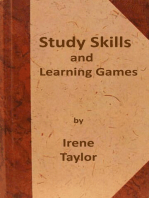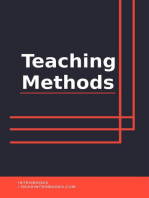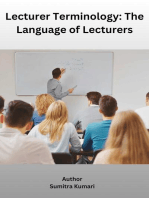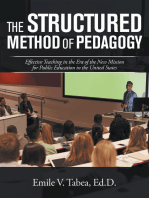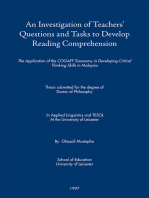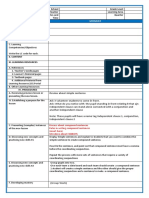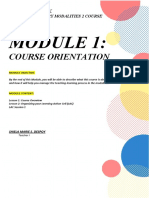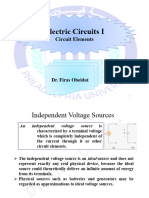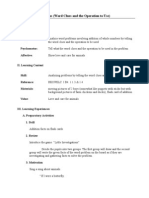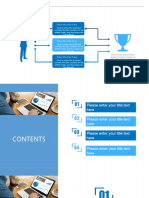0 ratings0% found this document useful (0 votes)
170 viewsLesson 2 Activity 4: Learning Tasks: MDL Tv/Rbi BL
This document provides a lesson plan for teaching third grade students how to write compound sentences. The lesson objectives are for students to write different types of compound sentences correctly using proper punctuation. The learning tasks include reviewing concepts from the previous lesson, presenting warm-up activities, checking prior knowledge, explaining and demonstrating compound sentence structures, providing feedback, and assessing whether students have mastered writing compound sentences. The lesson resources are a printed module.
Uploaded by
Shiela Marie Galo Sanico-DespoyCopyright
© © All Rights Reserved
Available Formats
Download as DOCX, PDF, TXT or read online on Scribd
0 ratings0% found this document useful (0 votes)
170 viewsLesson 2 Activity 4: Learning Tasks: MDL Tv/Rbi BL
This document provides a lesson plan for teaching third grade students how to write compound sentences. The lesson objectives are for students to write different types of compound sentences correctly using proper punctuation. The learning tasks include reviewing concepts from the previous lesson, presenting warm-up activities, checking prior knowledge, explaining and demonstrating compound sentence structures, providing feedback, and assessing whether students have mastered writing compound sentences. The lesson resources are a printed module.
Uploaded by
Shiela Marie Galo Sanico-DespoyCopyright
© © All Rights Reserved
Available Formats
Download as DOCX, PDF, TXT or read online on Scribd
You are on page 1/ 2
Lesson 2 Activity 4: Learning Tasks
Learning Delivery Modality (select one): ☐ODL ☒MDL ☐TV/RBI ☐BL
Grade Level and Learning Area: MTB 3
Lesson/Topic: Writing compound sentences.
Learning Objectives: Write correctly different types of compound sentences. Construct sentences observing
appropriate punctuation mark. Express love for stories and other text by browsing the
books and reading more stories and texts.
Learning Resources/Materials Needed: Printed module
Part of Lesson / Learning Tasks Check if Additional Remarks:
already (ex. can be done via voice calls, can be facilitated by a household
partner, can be done via a learning activity sheet, can be presented
present in the
via an internet- based resource, can be facilitated during a
SLM synchronous learning session, etc.)
Before the Lesson
1. Review previous lesson /
2. Clarify concepts from previous lesson /
3. Present warm-up activities to establish interest /
in new lesson
4. Check learner’s prior knowledge about the new /
lesson
5. Present connection between old and new /
lesson and establish purpose for new lesson
6. State lesson objectives as guide for learners /
Lesson Proper
1. Explain, model, demonstrate, and illustrate /
the concepts, ideas, skills, or processes that
students will eventually internalize.
2. Help learners understand and master new /
Information
3. Provide learners with feedback. /
4. Check for learners’ understanding /
After the Lesson
1. Wrap up activities /
2. Emphasize key information and concepts /
discussed
3. Ask learners to recall key activities and /
concepts discussed
4. Reinforce what teacher has taught /
5. Assess whether lesson has been mastered /
6. Transfer ideas and concepts to new /
situations
You might also like
- Lesson Plan (Types of Sentence Structure) For COT89% (9)Lesson Plan (Types of Sentence Structure) For COT5 pages
- Quick and Easy - How to Make an "A" - In a Nutshell: No More Questions Unanswered!From EverandQuick and Easy - How to Make an "A" - In a Nutshell: No More Questions Unanswered!No ratings yet
- Teaching English to Young Learners: Teacher DevelopmentFrom EverandTeaching English to Young Learners: Teacher Development4/5 (5)
- Task-based grammar teaching of English: Where cognitive grammar and task-based language teaching meetFrom EverandTask-based grammar teaching of English: Where cognitive grammar and task-based language teaching meet3.5/5 (4)
- Compound Sentences Lesson Plan 3C - ThursdayNo ratings yetCompound Sentences Lesson Plan 3C - Thursday2 pages
- Learning How to Learn: ‘A Guide to Effective Teaching and Learning Strategies’From EverandLearning How to Learn: ‘A Guide to Effective Teaching and Learning Strategies’4.5/5 (3)
- The Structured Method of Pedagogy: Effective Teaching in the Era of the New Mission for Public Education in the United StatesFrom EverandThe Structured Method of Pedagogy: Effective Teaching in the Era of the New Mission for Public Education in the United StatesNo ratings yet
- Teacher Guide for A Girl Called Echo: Learning About the History and Culture of the Métis Nation in Grades 6–8From EverandTeacher Guide for A Girl Called Echo: Learning About the History and Culture of the Métis Nation in Grades 6–8No ratings yet
- Cot - English 4-Q4-WK 10-Gary C. RodriguezNo ratings yetCot - English 4-Q4-WK 10-Gary C. Rodriguez5 pages
- Bulletproof Learning: Step-By-Step to Mastering Online Courses With Effective Note-TakingFrom EverandBulletproof Learning: Step-By-Step to Mastering Online Courses With Effective Note-TakingNo ratings yet
- Creating Activities for Different Learner Types: A Guide for ELT Teachers, Trainers, and WritersFrom EverandCreating Activities for Different Learner Types: A Guide for ELT Teachers, Trainers, and Writers5/5 (1)
- Five D’s of Instructional Design: Empowering Student-Centered Learning Excellence: Unveiling the 5 D's Framework for TransformationFrom EverandFive D’s of Instructional Design: Empowering Student-Centered Learning Excellence: Unveiling the 5 D's Framework for TransformationNo ratings yet
- The Beginner's Guide to Cooperative Learning: Make your learners your main teaching resourceFrom EverandThe Beginner's Guide to Cooperative Learning: Make your learners your main teaching resourceNo ratings yet
- IGCSE Simple, Compound, Complex Sentences Resource Pack100% (2)IGCSE Simple, Compound, Complex Sentences Resource Pack18 pages
- DLL-Second-Quarter - Sentence-According-to-Structure 2100% (1)DLL-Second-Quarter - Sentence-According-to-Structure 24 pages
- Blueprint For Thoughtful Lesson Planning: Excavating For Conceptual UnderstandingFrom EverandBlueprint For Thoughtful Lesson Planning: Excavating For Conceptual UnderstandingNo ratings yet
- Teaching Basic Engineering mechanics for optimum student involvementFrom EverandTeaching Basic Engineering mechanics for optimum student involvementNo ratings yet
- An Investigation of Teachers’ Questions and Tasks to Develop Reading Comprehension: The Application of the Cogaff Taxonomy in Developing Critical Thinking Skills in MalaysiaFrom EverandAn Investigation of Teachers’ Questions and Tasks to Develop Reading Comprehension: The Application of the Cogaff Taxonomy in Developing Critical Thinking Skills in MalaysiaNo ratings yet
- Daily Lesson Log (Pang-Araw-Araw Na Tala NG Pagtuturo) School Grade Level Teacher Learning Area Teaching Dates and Time QuarterNo ratings yetDaily Lesson Log (Pang-Araw-Araw Na Tala NG Pagtuturo) School Grade Level Teacher Learning Area Teaching Dates and Time Quarter3 pages
- LDM2-Module 3A: Designing Instruction in The Different Learning Delivery Modalities100% (1)LDM2-Module 3A: Designing Instruction in The Different Learning Delivery Modalities1 page
- Semi-Detailed Lesson Plan in Grade 11 General MathematicsNo ratings yetSemi-Detailed Lesson Plan in Grade 11 General Mathematics4 pages
- TLE-HECK10PGD-III-25: LM Cookery Grade 10 Pp. 290-294No ratings yetTLE-HECK10PGD-III-25: LM Cookery Grade 10 Pp. 290-2944 pages
- Assessment Method How To Adapt The Assessment Method in DLNo ratings yetAssessment Method How To Adapt The Assessment Method in DL1 page
- Region: Caraga: For Example, If You Disagree or Strongly Disagree, Please Indicate Why.)No ratings yetRegion: Caraga: For Example, If You Disagree or Strongly Disagree, Please Indicate Why.)2 pages
- Learner Group Targeted Intervention: Designing Instruction in The Different Learning Delivery ModalitiesNo ratings yetLearner Group Targeted Intervention: Designing Instruction in The Different Learning Delivery Modalities1 page
- The Process of Washing and Sanitizing Dishes, Glassware, Flatware, and Pots and Pans Either Manually or MechanicallyNo ratings yetThe Process of Washing and Sanitizing Dishes, Glassware, Flatware, and Pots and Pans Either Manually or Mechanically3 pages
- Microstation V8 2004 Edition: Pattern/Graphics IssueNo ratings yetMicrostation V8 2004 Edition: Pattern/Graphics Issue7 pages
- Comparative Stdy of Wind Analysis of Different Plan Configuration Building Using ETabsNo ratings yetComparative Stdy of Wind Analysis of Different Plan Configuration Building Using ETabs18 pages
- Lecture Powerpoint: Physics: Principles With Applications, 6 EditionNo ratings yetLecture Powerpoint: Physics: Principles With Applications, 6 Edition21 pages
- MT CE Inerting in The Chemical Industry UK A5 Fin tcm17-630096No ratings yetMT CE Inerting in The Chemical Industry UK A5 Fin tcm17-63009629 pages
- Analyzing Word Problems (Word Clues and The Operation To Use)No ratings yetAnalyzing Word Problems (Word Clues and The Operation To Use)5 pages
- Symbolic Violence As A Form of Violence Against WoNo ratings yetSymbolic Violence As A Form of Violence Against Wo12 pages
- Points East and West: Acupuncture and Comparative Philosophy of ScienceNo ratings yetPoints East and West: Acupuncture and Comparative Philosophy of Science10 pages
- Proposal Sponsorship Xendit Conference 2024No ratings yetProposal Sponsorship Xendit Conference 202430 pages
- Composite Fabrication by Filament WindingNo ratings yetComposite Fabrication by Filament Winding26 pages
- LRFD Pre Standard - Revised FINAL - Nov 9 2010No ratings yetLRFD Pre Standard - Revised FINAL - Nov 9 2010215 pages















